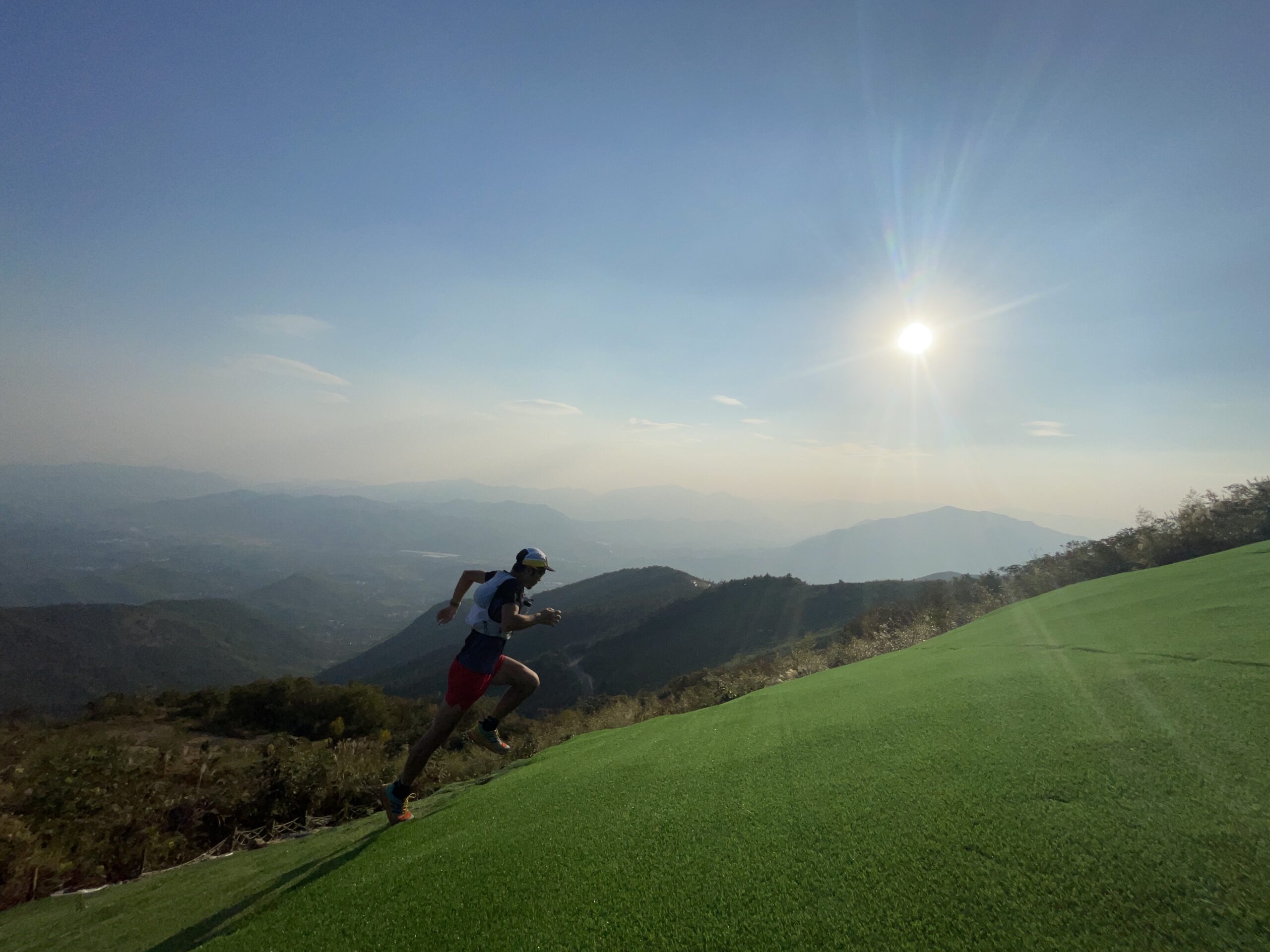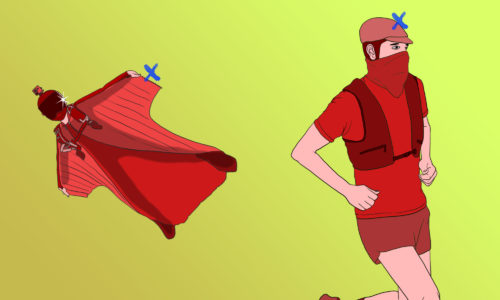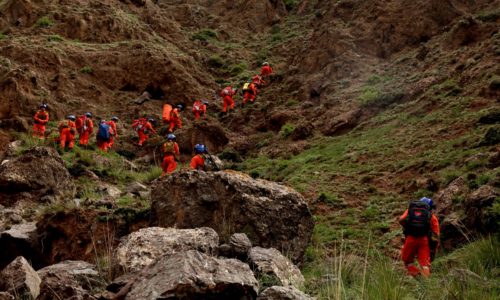Crushed by the pandemic, China’s trail running events are making a comeback
China’s trail runners are back in force, with the resumption of ultramarathon competitions and government money flowing back into the sport. But there's still miles to go on the road to recovery.

On a smoggy day in November 2022, Yú Chūnhuī 虞春晖 marches his way up a steep slope in Beijing’s mountainous suburb of Mentougou. As China’s COVID restrictions have just loosened, Yu is joined by around 120 other participants completing a 22-kilometer (14-mile) trail that includes 1,700 meters (5,600 feet) of ascent through forest and along rocky paths.
“Trail running is about challenging yourself, breaking through your own limits,” Yu, a local who took up the sport in 2018, says after the race. “There’s always risks in the mountains, especially at high altitude…rescuers can’t get to you like they could in the city. But you don’t get mountain scenery in the city either.”
After three years in the wilderness, trail runners are filling China’s mountains again. But trail running enthusiasts — who, unlike road runners, jog mountainous routes often on hiking trails with large changes in elevation — have had to weather twin disasters since 2020, both of which threatened to derail their sport’s rapid rise. First, the pandemic saw races canceled, organizers go out of business, and enthusiasts frustrated by lockdowns and restrictions. Then, the country’s worst-ever running disaster left 21 dead from hypothermia at a 100-kilometer trail run in Baiyin, Gansu province, and led to a ban on almost all races for a year after.
But neither put off runners like Yu. With the ban lifted and COVID restrictions fast becoming a distant memory, China’s trail running industry is trying to reset and perhaps grow again, even while the specter of the Gansu tragedy continues to loom over the sport.
Surviving the pandemic
During the pandemic, “Runners were less, races were less, and a lot of trail running companies closed down,” says Gǔ Hànjié 古汉杰, a semi-professional trail runner from Guangzhou who took up the sport in 2018. He has competed in 70 to 80 races, winning some of them. China’s General Administration of Sport (GAS) effectively halted all ultramarathon (which includes any running race over marathon distance, or 42.195 kilometers) and trail running events for around a year after the tragedy in Gansu, ordering local authorities to conduct risk assessments of planned events and pledging to devise new safety regulations for races.
Before 2020, Chinese trail running had seen frenetic growth. There were around 500 trail races in China in 2019, up from less than 10 before 2013 and 73 in 2015. Gu was running a race almost every week in 2019. “There were so many races, there weren’t enough runners for them all,” he recalls. Gu ran in events across the country, along with perhaps 150,000 others (mostly white-collar workers, aged 26 to 45, and from China’s major cities like Beijing and Shanghai). Two-thirds of those have registered with the International Trail Running Association (ITRA), an international body that monitors the sport and certifies certain races — registered Chinese runners are second only to French, who number nearly 300,000. Anthony Marguet, the China commercial manager of Salomon, told Reuters in 2018 he expected the number of runners to perhaps triple over the next five years.
Instead, the number of events fell off a cliff. Two hundred were held in 2021 before the tragedy in May, then almost none were held for a year. Even after the ban was lifted, COVID-19 outbreaks and restrictions canceled dozens of races. The growth in trail running event companies slowed, from over 120 new ones in 2016 to just 16 in 2021 (a year when 11 also went out of business), according to a 2021 industry report by Outdoor magazine.
But now? “I feel the whole scene is about 80% recovered, there are races every week again,” Gu says.
And it couldn’t have come soon enough. “Before the pandemic, everyone was very enthusiastic, there were lots of events, and business was quite good,” says Shěn Míng 沈明, the owner of a trail running equipment shop in Beijing. “But during the three years of the pandemic, many other stores went under, and we’ve just started to recover now.”
Shen’s store has been in business for seven years, so he had a solid customer base to pull through the pandemic. He is also a trail running enthusiast who took up the sport early in 2015. During the pandemic, he recruited minor Douyin (the Chinese version of TikTok) celebrities, many of them trail running friends of his, to help sell trainers and other equipment, and has continued the technique since because of the good results.
Big business for small economies
The semi-professional runner Gu also advertises trail running training programs on Xiaohongshu, a social media platform full of fitness content and, increasingly, trail running posts. Influencers share pictures and videos of their latest routes and the scenery, as well as advertising gear from their sponsors or selling directly. The most popular channels have over 1 million fans, modest by Chinese influencer standards but representative of the boom in popularity of trail running over the last few years. Gu has become successful enough to earn sponsorship from outdoor equipment brand Kailas, which covers his entrance fees and equipment for races, while more casual runners, like Yu, spend significant cash and time on their hobby.
“If you sign up for a 100-kilometer race, the registration fee is 1,000 yuan ($150), then you add transportation and accommodation, and then you also have to take time off work; all kinds of costs are very high,” says Shen. Trail running shoes typically cost from 700 to 1,500 yuan and may last just six months for frequent runners due to the harsh rocky terrain they often pound across. After purchasing other equipment like running backpacks, lightweight poles, hats, and energy gels, the costs can quickly escalate.
The sport has become big business, which is not always conducive to safe racing. For the Baiyin event, the organizing company won a 1.5 million yuan ($220,000) bid to run the race in 2018, while in the 2021 race over 170 runners paid 1,000 yuan each to enter. That’s significant income for the local economy in what is a relatively poor region.
Meanwhile, the Chongli 168 Ultra Trail race in Hebei province, one of China’s largest events, had 7,000 competitors last offer (as one of the first big races held after the Baiyin disaster), across 13 race distances from 4 kilometers to 193 kilometers, with entrance fees from 198 yuan ($29) for the shortest race up to 1,698 ($250) yuan for the longest. The event had over 50 sponsors, from Adidas (the main sponsor) to Sanfo (one of the largest outdoor retailers in China), plus internet giants like Netease. The most prestigious races have cash prizes of up to 30,000 yuan ($4,400) for the top placed runners, according to Gu.
The big money hasn’t escaped the media or the government’s attention: an article on the website of the Communist Party’s Central Commission for Discipline Inspection immediately after the Gansu tragedy in May 2021 accused the event’s organizers of prioritizing profit over safety. Caixin reported that the company charged with organizing the event, Gansu Shengjing Sports and Culture Development, won the right to host the race from the local government in a noncompetitive bidding process, and had only a handful of temporary staff at the race. Though the direct cause of death for the runners was hypothermia caused by a sudden plunge in temperatures, a report by the Gansu provincial Party committee and government released a month after the disaster mainly blamed organizers for failing to ensure adequate safety measures and being too slow to cancel the race after the weather turned.
“I feel strongly about that race, because I ran it in 2019,” says Gu. That was his first 100-kilometer run, but “at that time I already felt this was a harsh environment…there was basically no staff on the road, the first 20 kilometers was through a village, but then you didn’t see anyone.” Gu had known most of the runners who lost their lives that day: “We would meet several times a year [at races],” he says.
Despite not experiencing acute danger while running himself, Gu stays away from races in more desolate environments now, avoiding high altitudes (above 2,000 meters), and attending mainly races within close reach of large cities, which he figures makes rescue easier.
“We have to respect nature and try to protect ourselves,” says Qín Chén 覃臣, a trail running enthusiast in Dali, Yunnan province. “[Baiyin] was a massive blow, because I had friends who passed away.” A trail runner since 2019, Qin often runs in the mountains around Dali, a picturesque lakeside city surrounded by peaks. “I used to wear just a t-shirt and wouldn’t bring anything with me up the mountains, but now I bring a jacket and an emergency blanket…I’m also not so desperate to run races, I just run for my own happiness.”
Fresh emphasis on safety
New regulations are meant to make the sport safer. In an amendment to the Measures for Sports Competitions (体育赛事活动管理办法 tǐyù sàishì huódòng guǎnlǐ bànfǎ) released in January this year by the GAS, “high risk” sports events must now apply for a special license from local sports bureaus. If a route reaches 3,500 meters in altitude, has any part take place at night, or is over the length of a marathon, it is now considered high risk, the same designation given to airplane competitions and skydiving. Punishments for organizers that violate regulations have also risen to fines up to 500,000 yuan ($73,000) and a ban on holding future events.
Qin has noticed clear changes for competitions. Before, many races advertised their routes as rugged, wild, and remote to entice competitors looking for the thrill of adventure, but now they’ve cut this marketing and their routes are more conservative, meaning runners spend less time on mountainous trails where rescue may be tricky. He also believes supply stations are closer together since the accident — every eight kilometers instead of 10, for example. Qin, Gu, and Shen also say that mandatory equipment, which generally includes waterproof jackets, emergency blankets, and sufficient food, is now checked more regularly and strictly, including random checks on the road and at the finish. “Some companies even require you to submit recent medical examination data” to check you are fit to race, says Gu, particularly since COVID began sweeping across China last December.
None of the runners The China Project talked to considered quitting trail runs after the Gansu accident. “It’s just one incident. There are traffic accidents every day, so if you’re scared of cars then do you not dare to drive?” says Yu Chunhui. “The incident at Baiyin should give everyone a wakeup call. You need to know the environment, and do as much as possible to be safe, bring as much equipment as possible, and know your own ability,”
“You don’t only need running ability for trail running, you need basic outdoor skills, and know how to protect yourself against nature,” says Shen.
Though most agree more attention needed to be paid to safety after the Baiyin disaster, a January article on Run Yeah, a popular trail running WeChat public account, argued that the new rules by the GAS amounted to a “one-size-fits-all” approach that didn’t address the root of the problem. The article, which had more than 25,000 views, suggested that pushing approval for events onto local government offices with little experience won’t help safety, while the extra approval fees would push smaller events out of business and raise costs for runners.
Luō Qíng 罗晴, a consultant in Beijing who runs trails most weekends, suspects the Baiyin disaster put some people off the sport for good. “This news [of the Baiyin disaster] is how most Chinese learned about trail running,” she says. Now, when she tells her colleagues she will take leave on a Friday to go trail running, “they are always shocked, they think it’s a dangerous sport. And my parents never encourage me to go.”
Despite its danger, and its still relatively niche status in comparison to road running or other sports, trail running’s allure is simply too strong for most who have already committed to it. Gu is even looking forward to competing abroad more, now that quarantine restrictions on arrival to the PRC have been lifted. He competed at the Hong Kong 100 Ultra Trail last month and is planning to compete in a 300-kilometer race in Italy in September.
Yu, meanwhile, is planning to run his first 100-kilometer race in the summer. “You get to see your own potential,” he says. He acknowledges there will also be some risk. “But you need to go out. There’s a Chinese saying, ‘It’s better to walk 1,000 li than read 10,000 books.’ You better get out there.”



